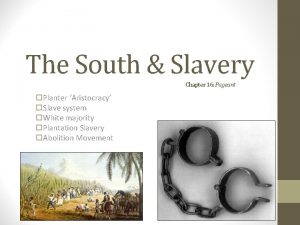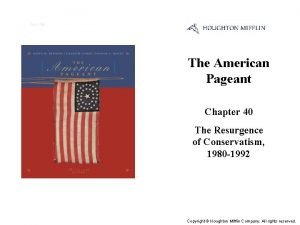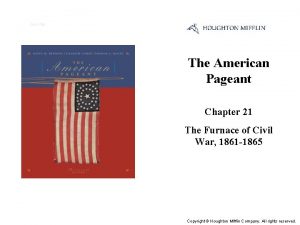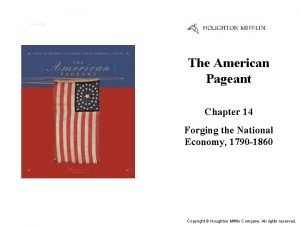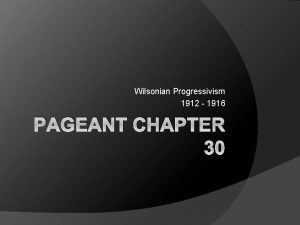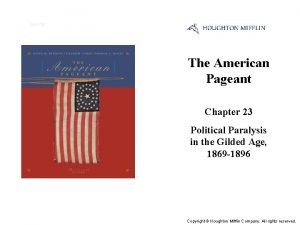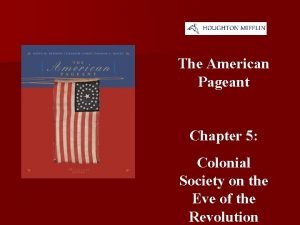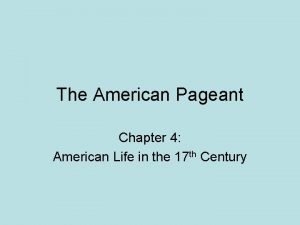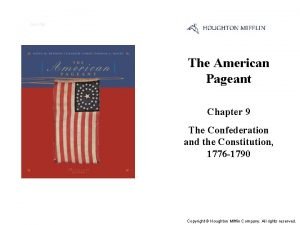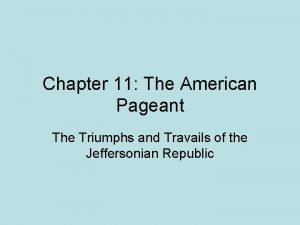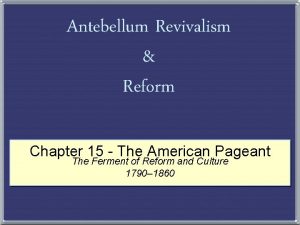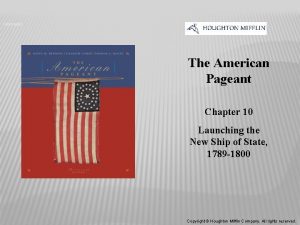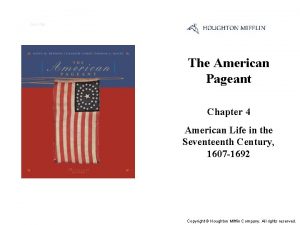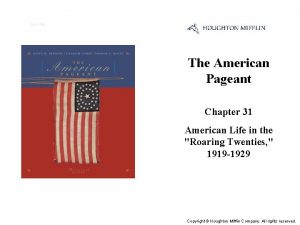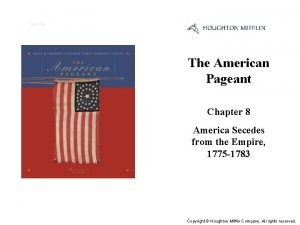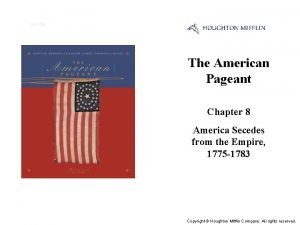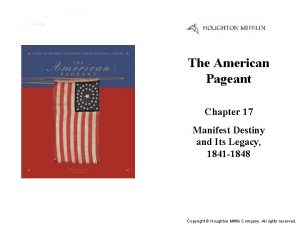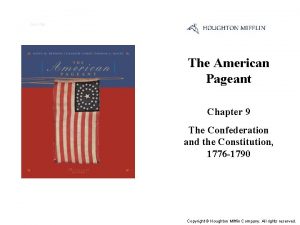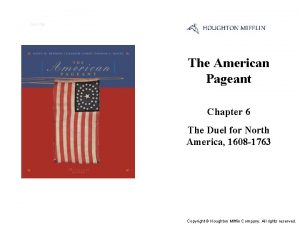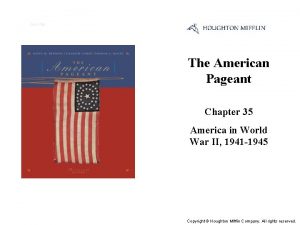Cover Slide The American Pageant Chapter 10 Launching
















- Slides: 16

Cover Slide The American Pageant Chapter 10 Launching the New Ship of State, 1789 -1800 Copyright © Houghton Mifflin Company. All rights reserved.

Alexander Hamilton by Charles Wilson Peale Author of many of The Federalist Papers essays and first Secretary of the Treasury, Alexander Hamilton was admired, even by bitter political opponents, for his intellectual brilliance and his political vision. Hamilton was a true American success story: an illegitimate son of a Barbados gentleman, he immigrated to the mainland as a teenager where he enjoyed a meteoric career. Hamilton served as Washington's aide-de-camp, became a leader of the New York bar, and entered New York's social elite by his marriage into the Schuyler family. In 1803, a political enemy, Aaron Burr, killed Hamilton in a duel. (Courtesy Independence National Historical Park Collection) Copyright © Houghton Mifflin Company. All rights reserved.

Alexander Hamilton by John Trumbull, 1792 Hamilton's self-confident pride clearly shines through in this portrait, painted at the height of his influence in the Washington administration. (Courtesy of Donaldson, Lufkin & Jenrette Collection of Americana) Copyright © Houghton Mifflin Company. All rights reserved.

Congressional Pugilists, 1798 A cartoonist satirizes the fiercely partisan debates in Congress surrounding the Alien and Sedition Acts. (Library of Congress) Copyright © Houghton Mifflin Company. All rights reserved.

Edmond Genêt by Ezra Ames, 1809– 1810 Citizen Edmond Genêt's visit caused the first major diplomatic crisis in the new nation. His attempts to enlist Americans in support of the French Revolution raised troubling questions about the international role of the United States. (Collection of the Albany Institute of History and Art. Bequest of George Genêt. ) Copyright © Houghton Mifflin Company. All rights reserved.

George Washington by John Trumbull, miniature, 1792– 1794 John Trumbull, known primarily for his larger-than-life portraits of patriot leaders, painted this miniature (c. 1792– 1794) of George Washington, who posed for it during his presidency. (Division of Political History, Smithsonian Institution, Washington, D. C. ) Copyright © Houghton Mifflin Company. All rights reserved.

George Washington's Inaugural Journey through Trenton, 1789 Washington received a warm welcome in Trenton, site of his first victory during the Revolutionary War. (Private Collection) Copyright © Houghton Mifflin Company. All rights reserved.

Liberty Displaying the Arts and Sciences by Samuel Jennings, 1792 How do historians know. . . that the 1780 s and 1790 s marked a crucial turning point in the history of slavery and racism in the United States? Emancipation, manumission, and miscegenation laws adopted by state legislatures, coupled with debates in pamphlets and newspapers, indicate a shift in Americans' thinking. A painting such as the one reproduced here, Liberty Displaying the Arts and Sciences, offers a unique visual perspective on the same developments. In 1792 the Library Company of Philadelphia, a private lending library founded in the mid-eighteenth century, commissioned the artist Samuel Jennings to produce a depiction of slavery and abolitionism showing the "figure of Liberty (with her cap and proper Insignia) displaying the arts. " The results reportedly pleased the library's directors. The painting, probably the first to celebrate emancipation, shows the blonde goddess presenting books (symbolizing knowledge and freedom) to several grateful blacks, while in the background former slaves dance joyfully around a liberty pole. Although theme is abolition and the African Americans in the foreground have realistic features, the portrayal of blacks in passive roles and diminutive sizes portended future stereotypes. Thus the picture linked emancipation and the growth of racism. (Photo from The Library of Congress of Philadelphia) Copyright © Houghton Mifflin Company. All rights reserved.

Native American signature marks on Greenville Treaty Independence sparked renewed westward migration by land hungry Americans. The federal government took steps to legitimate these incursions into Indian homelands by persuading selected chiefs and warriors of the northwest to cede all rights to vast tracts of this Ohio Valley land. The document pictured here provides a sample of the eleven hundred signatures obtained in the Greenville Treaty of 1795, a treaty that ceded almost two-thirds of present day Ohio and portions of Indiana. Many tribes protested such treaties on the grounds that the signers were not legitimate spokesmen for their people. (Library of Congress) Copyright © Houghton Mifflin Company. All rights reserved.

Property Protected, a la Francoise This cartoon, drawn during the XYZ affair, depicts the United States as a maiden being victimized by the five leaders of the French government's directorate. In the background, John Bull (England) watches from on high, while other European nations discuss the situation. (The Lilly Library, Indiana University, Bloomington, Indiana) Copyright © Houghton Mifflin Company. All rights reserved.

Signing of the Constitution of the United States by Thomas Pritchard Rossiter, 1867 In 1867, Thomas Pritchard Rossiter painted his Signing of the Constitution of the United States, honoring a group of statesmen that included James Madison, Alexander Hamilton, and George Washington, who presided over the Constitutional Convention. Thomas Jefferson, absent because of his duties as ambassador to France, referred to the fifty-five delegates who crafted the Constitution as a gathering of "demigods. " (Fraunces Tavern Museum) Copyright © Houghton Mifflin Company. All rights reserved.

Sketch of Stockbridge Indian serving with the American Army Like other Native Americans in locales long dominated by whites, the Stockbridge Indians of western Massachusetts contributed substantially to the patriots' military effort. (From Joseph P. Tustin, Diary of the American War: A Hessian Journal by Captain Johann Ewald, Field Jager Corps. (New Haven, Conn. : Yale University Press, 1979). By permission of Yale University Press. ) Copyright © Houghton Mifflin Company. All rights reserved.

Tax collector scene from Whiskey Rebellion In 1794, the new federal government passed an excise tax on whiskey made from surplus American grains. Farmers in western Pennsylvania rose up in protest against what they considered an unfair assault on their livelihood. Using tactics straight out of the pre-Revolutionary War era, including tarring and feathering the "revenooer" assigned to collect the taxes, the "Whiskey Rebels" challenged the federal government's authority. President Washington met this challenge by assembling an army of almost 13, 000 men to put down the Whiskey Rebellion. Critics declared the president's response excessive. Do you agree? (Library of Congress) Copyright © Houghton Mifflin Company. All rights reserved.

Treaty of Greenville In the Treaty of Greenville, the United States formally accepted the principle of Indian sovereignty, by virtue of residence, over all lands the native peoples had not ceded. (National Archives) Copyright © Houghton Mifflin Company. All rights reserved.

Washington Taking the Oath George Washington was the most admired man in eighteenth-century America. Even before the Constitution was ratified, his name was widely proposed for the presidency. "Of all Men you are best fitted to fill that Office, " wrote one friend, and indeed, Washington was unanimously elected to serve as the first president of the United States. Along the route from his home at Mount Vernon, Virginia, to his inauguration at New York City, Washington was greeted by cheering crowds, bands, and parades. Barges, decorated in patriotic themes, accompanied him as he crossed the Hudson River. In this painting, the artist captures the enthusiasm and patriotism of the crowd that has gathered to see the general take the oath of office. (Library of Congress) Copyright © Houghton Mifflin Company. All rights reserved.

Map: Presidential Election, 1800 The Democratic-Republicans, with their candidates Thomas Jefferson and Aaron Burr, won the electoral votes of the southern states, while the Federalists, the party of John Adams and Charles Cotesworth Pinckney, received votes primarily in New England. The parties split the votes of the middle states, but the Democratic-Republicans dominated the electoral-vote count there and won the election. Copyright © Houghton Mifflin Company. All rights reserved.
 American pageant chapter 16
American pageant chapter 16 American pagent chapter 35
American pagent chapter 35 Chapter 40 american pageant
Chapter 40 american pageant American pagent chapter 21
American pagent chapter 21 American pageant chapter 14
American pageant chapter 14 American pageant chapter 13
American pageant chapter 13 American pageant chapter 30
American pageant chapter 30 Chapter 23 american pageant
Chapter 23 american pageant American pageant chapter 34
American pageant chapter 34 Chapter 5 american pageant
Chapter 5 american pageant Chapter 4 the american pageant
Chapter 4 the american pageant American pagent chapter 9
American pagent chapter 9 American pageant chapter 11
American pageant chapter 11 American pageant chapter 15
American pageant chapter 15 Chapter 41 american pageant
Chapter 41 american pageant American pageant chapter 29
American pageant chapter 29 Heel toe polka
Heel toe polka
